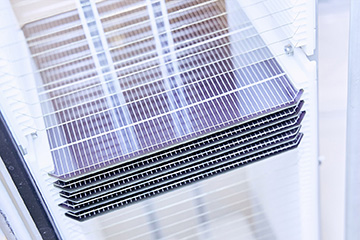
A perovskite-on-silicon tandem solar cell. [Image: Oxford PV]
When it comes to solar photovoltaics, systems based on crystalline silicon still dominate the market despite the availability of commercial alternatives. In 2020, silicon wafer–based photovoltaic technology accounted for 95% of total global production volume. However, crystalline silicon solar cells are expected to hit a practical cell efficiency limit of about 26% in production.
Taking a different tack, in a recent study, researchers at the firm Oxford PV, UK, suggest that the next viable step for the photovoltaics industry is the tandem solar cell (Appl. Phys. Lett., doi: 10.1063/5.0054086). In particular, they outline the company’s success in creating a commercial perovskite/silicon tandem device with power conversion efficiency of 29.52%, which surpasses the upper theoretical limit of crystalline silicon solar cells (29.5%).
Working in tandem
Tandem cells combine two types of solar absorber materials that split the solar spectrum into multiple bands to achieve greater efficiency. For example, a bottom cell with a band gap between 0.8 and 1.2 eV, coupled to a top cell with a band gap between 1.5 and 1.8 eV, could, in principle, reach power conversion efficiencies greater than 40%.
Oxford PV, a spinoff from a University of Oxford laboratory, began working with perovskite as a solar absorber in 2013. With their low material cost, ease of fabrication, and rapidly improving power conversion efficiencies, perovskite devices had become a potential leading candidate for the next generation of commercial solar cells (see “Perovskite Photovoltaics: The Road Ahead,” OPN, November 2020). For their tandems, the researchers settled on using tried-and-true silicon for the bottom cell and up-and-coming perovskite for the top cell.
“We knew back then that the perovskite can be used by itself as a thin-film technology,” said Laura Miranda Pérez, study author and Head of Materials Research at Oxford PV. “However, why would [we have] a newly discovered technology compete with a well-established one, instead of making it work together and make use of the learning curve and current manufacturing structures? And the decision was made.”
Record-breaking efficiency
With the perovskite layer capturing the blue region of the solar spectrum, while the silicon layer picks up the red region, their recently certified tandem device reached an efficiency of 29.52%, which the authors say exceeds that of all non-concentrated, single-junction solar technologies. Miranda Pérez and her colleagues argue that the boost in power output outweighs the additional manufacturing cost of creating tandem solar cells.
“Our final product can produce at least 20% more power output compared with conventional silicon cells,” she said. “The much higher efficiencies of our solar cell are very well suited as a premium product for space-constrained areas, such as rooftops. You get more power from the same area.”
The company’s tandem cells are heavy and rigid, with a size and shape that matches traditional silicon solar cells. The researchers had a number of challenges to overcome along the way, including integrating perovskite into the current mainstream silicon production line and making sure the perovskite layer will remain stable over the industry expectation of 25 years or more.
Entering the market
But Miranda Pérez claims those issues have been solved, and Oxford PV is now completing installation of the world’s first perovskite-on-silicon production line in Germany with hopes to enter the market by 2022. While long-term stability has been a troubling problem for perovskites, the tandem cell has passed a series of accelerated stress tests for outdoor silicon cells, known as the IEC 61215, from the International Electrotechnical Commission.
“We continue to develop for improvements on our current product with a roadmap setting the pathway to 33% solar cells,” said Miranda Pérez. “At the same time, we are looking at next-generation devices which potentially can reach efficiencies as high as 39%.”
